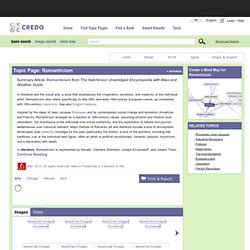

Log in to use SFCC Library online services. Growing in Pre K - Science. Jesse Roman. 1. Jesse Roman. 2. Journal of the History of Ideas, Vol. 36, No. 3 (Jul. - Sep., 1975), pp. 563-572. Log in to use SFCC Library online services. Log in to use SFCC Library online services. Log in to use SFCC Library online services. Log in to use SFCC Library online services. Log in to use SFCC Library online services. Log in to use SFCC Library online services. Log in to use SFCC Library online services. SELECT LIBRARY. SELECT LIBRARY. SELECT LIBRARY. Romanticism - Credo Reference Topic. In literature and the visual arts, a style that emphasizes the imagination, emotions, and creativity of the individual artist.

Romanticism also refers specifically to late-18th- and early-19th-century European culture, as contrasted with 18th-century classicism. See also English literature. Inspired by the ideas of Jean Jacques Rousseau and by contemporary social change and revolution (American and French), Romanticism emerged as a reaction to 18th-century values, asserting emotion and intuition over rationalism, the importance of the individual over social conformity, and the exploration of natural and psychic wildernesses over classical restraint. Major themes of Romantic art and literature include a love of atmospheric landscapes (see sublime); nostalgia for the past, particularly the Gothic; a love of the primitive, including folk traditions; cult of the individual hero figure, often an artist or political revolutionary; romantic passion; mysticism; and a fascination with death.
Log in to use SFCC Library online services. Log in to use SFCC Library online services. Log in to use SFCC Library online services. Romanticism from The Bloomsbury Guide to Art. Romanticism from Aesthetics A-Z. SFCC Home. Log in to use SFCC Library online services.